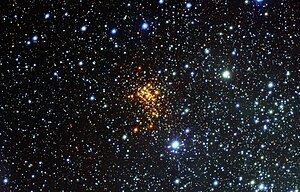Westerlund 1-75
Coordinates: ![]() 16h 47m 08.93s, −45° 49′ 58.45″
16h 47m 08.93s, −45° 49′ 58.45″
| Observation data Epoch J2000 Equinox J2000 | |
|---|---|
| Constellation | Ara |
| Right ascension | 16h 47m 08.93s[1] |
| Declination | −45° 49′ 58.6″[1] |
| Apparent magnitude (V) | 16.7 |
| Characteristics | |
| Evolutionary stage | Red supergiant |
| Spectral type | M1[2] - M4Ia[3] |
| Apparent magnitude (J) | 6.933 |
| Apparent magnitude (H) | 4.673 |
| Apparent magnitude (K) | 3.28 |
| Astrometry | |
| Radial velocity (Rv) | −50.6±2.9[4] km/s |
| Proper motion (μ) | RA: −2.029[4] mas/yr Dec.: −4.248[4] mas/yr |
| Details | |
| Radius | 722±36[2] R☉ |
| Luminosity | 120,000±14,000[2] L☉ |
| Temperature | 3,600[1] - 4,000[2] K |
| Other designations | |
Westerlund 1 W75, Westerlund 1 BKS E, 2MASS J16470892-4549585, Gaia EDR3 5940199877892579584 | |
| Database references | |
| SIMBAD | data |
Westerlund 1-75 or Wd 1-75 is a red supergiant (RSG) located in the Westerlund 1 super star cluster. Its radius was calculated to be around 668 solar radii[1] (4.65 × 108 km, 3.10 au). This corresponds to a volume 298 million times bigger than the Sun. If placed at the center of the Solar System, Westerlund 1-75 would engulf the inner limits of the asteroid belt.

The star is classified as a luminous cool supergiant emitting most of its energy in the infrared spectrum.[5] It occupies the upper right corner of the Hertzsprung-Russell diagram. Using the effective temperature of 3,600 K,[1] the bolometric luminosity of 68,000 L☉[1] and the solar effective temperature of 5,772 K,[6] the radius of Westerlund 1-75 can be calculated using the Stefan-Boltzmann law.[a]
Like Westerlund 1-20, Westerlund 1-26 and Westerlund 1-237, Westerlund 1-75 was observed to be a radio source, however it is weakest along the RSGs in its cluster and remains unresolved at any wavelength.[7]
Westerlund 1-75 is surrounded by extended nebula, although it appears less massive than nebulae around typical red supergiant stars.[8]
See also[]
Notes[]
References[]
- ^ a b c d e f Fok, Thomas K. T.; Nakashima, Jun-Ichi; Yung, Bosco H. K.; Hsia, Chih-Hao; Deguchi, Shuji (2012). "Maser Observations of Westerlund 1 and Comprehensive Considerations on Maser Properties of Red Supergiants Associated with Massive Clusters". The Astrophysical Journal. 760 (1): 65. arXiv:1209.6427. Bibcode:2012ApJ...760...65F. doi:10.1088/0004-637X/760/1/65. S2CID 53393926.
- ^ a b c d Arévalo, Aura (2019). The Red Supergiants in the Supermassive Stellar Cluster Westerlund 1 (Thesis). doi:10.11606/D.14.2019.tde-12092018-161841.
- ^ Clark, J. S.; Ritchie, B. W.; Negueruela, I. (2010). "A serendipitous survey for variability amongst the massive stellar population of Westerlund 1". Astronomy and Astrophysics. 514: A87. arXiv:1003.5107. Bibcode:2010A&A...514A..87C. doi:10.1051/0004-6361/200913820. S2CID 14780809.
- ^ a b c Brown, A. G. A.; et al. (Gaia collaboration) (2021). "Gaia Early Data Release 3: Summary of the contents and survey properties". Astronomy & Astrophysics. 649: A1. arXiv:2012.01533. Bibcode:2021A&A...649A...1G. doi:10.1051/0004-6361/202039657. S2CID 227254300. Gaia EDR3 record for this source at VizieR.
- ^ "Cl* Westerlund 1 W 75". Simbad.
- ^ Williams, D. R. (2013). "Sun Fact Sheet".
- ^ Dougherty, S. M.; Clark, J. S.; Negueruela, I.; Johnson, T.; Chapman, J. M. (2010-02-01). "Radio emission from the massive stars in the galactic super star cluster Westerlund 1". Astronomy & Astrophysics. 511: A58. arXiv:0912.4165. Bibcode:2010A&A...511A..58D. doi:10.1051/0004-6361/200913505. ISSN 0004-6361.
- ^ Andrews, H.; Fenech, D.; Prinja, R. K.; Clark, J. S.; Hindson, L. (2018). "Asymmetric ejecta of cool supergiants and hypergiants in the massive cluster Westerlund 1". Monthly Notices of the Royal Astronomical Society: Letters. 477 (1): L55–L59. arXiv:1803.07008. Bibcode:2018MNRAS.477L..55A. doi:10.1093/mnrasl/sly046. S2CID 53640431.
- Ara (constellation)
- M-type supergiants
- 2MASS objects

